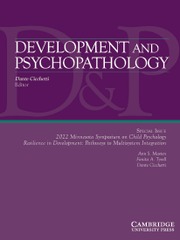Article contents
Attachment security, environmental adversity, and fast life history behavioral profiles in human adolescents
Published online by Cambridge University Press: 23 September 2024
Abstract
One species-general life history (LH) principle posits that challenging childhood environments are coupled with a fast or faster LH strategy and associated behaviors, while secure and stable childhood environments foster behaviors conducive to a slow or slower LH strategy. This coupling between environments and LH strategies is based on the assumption that individuals’ internal traits and states are independent of their external surroundings. In reality, individuals respond to external environmental conditions in alignment with their intrinsic vitality, encompassing both physical and mental states. The present study investigated attachment as an internal mental state, examining its role in mediating and moderating the association between external environmental adversity and fast LH strategies. A sample of 1169 adolescents (51% girls) from 9 countries was tracked over 10 years, starting from age 8. The results confirm both mediation and moderation and, for moderation, secure attachment nullified and insecure attachment maintained the environment-LH coupling. These findings suggest that attachment could act as an internal regulator, disrupting the contingent coupling between environmental adversity and a faster pace of life, consequently decelerating human LH.
Keywords
- Type
- Regular Article
- Information
- Copyright
- © The Author(s), 2024. Published by Cambridge University Press
References
- 1
- Cited by



